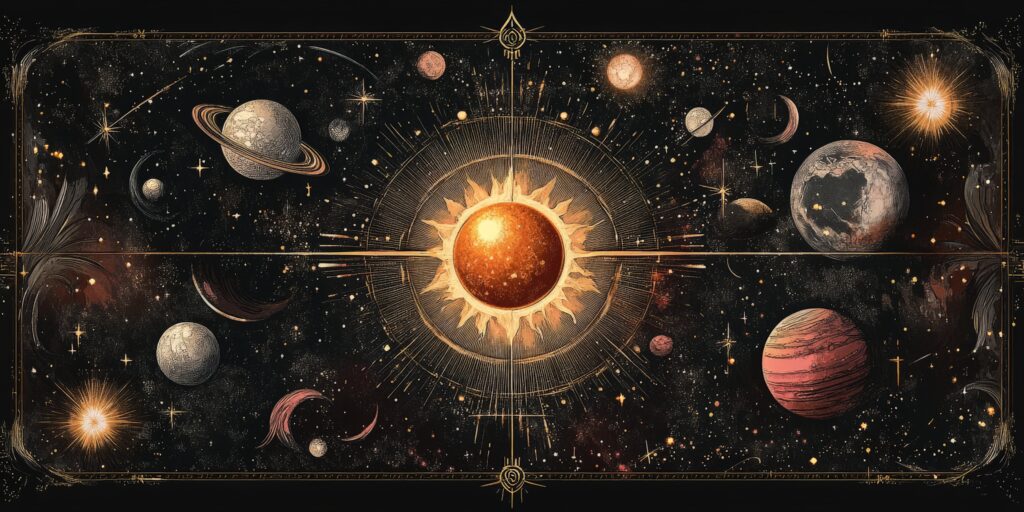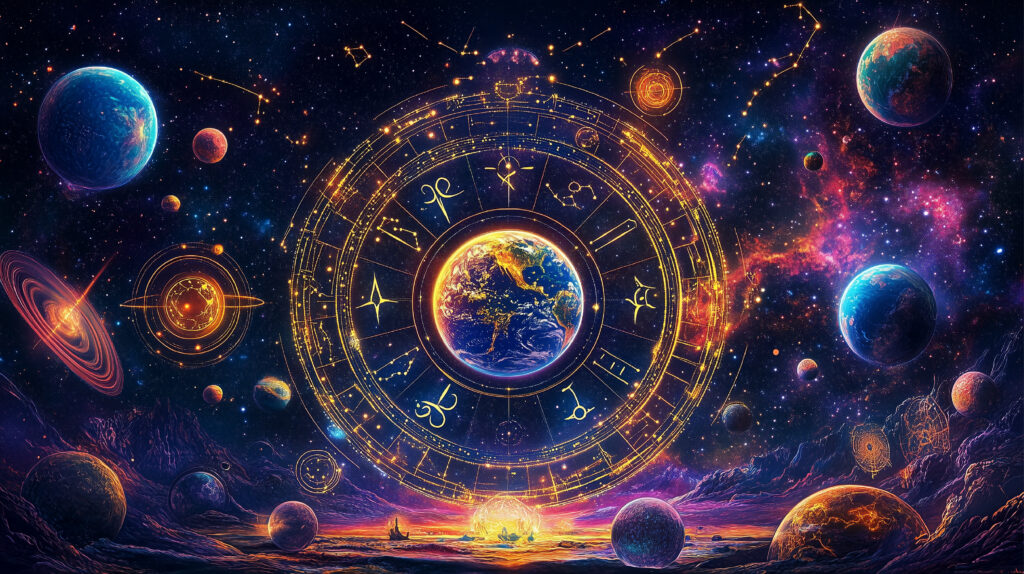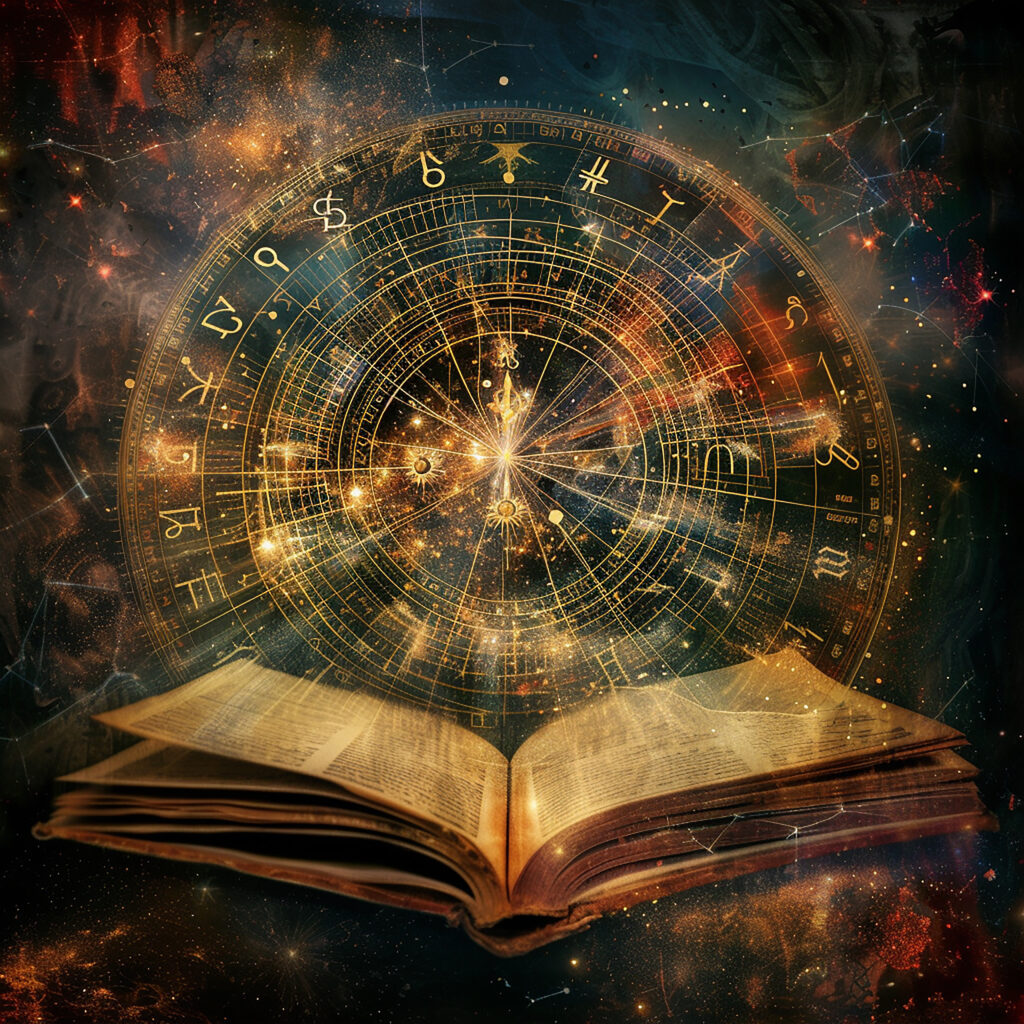Summary
Astrology provides insight into human experiences through the astrological significance of ten celestial bodies: the Sun, Moon, Mercury, Venus, Mars, Jupiter, Saturn, Uranus, Neptune, and Pluto. Their positions and movements within the zodiac deeply influence individual destiny and personality, as interpreted in birth charts. The Sun symbolizes core identity and purpose while the Moon reflects our emotional and nurturing side. Mercury, Venus, and Mars dictate our communication, love, and ambition, shaping how we engage with the world.
Jupiter and Saturn introduce growth and structure to our lives, encouraging prosperity and instilling discipline, respectively. Uranus sparks innovation and disruption, Neptune blurs the lines with its illusions and dreams, and Pluto orchestrates profound transformations. These celestial bodies, aligned against the zodiac, inform horoscopic astrology, offering a guide to navigate the cycles of life. Analyzing natal charts and planetary aspects reveals individual potential and life narratives, influenced by the dynamic celestial interactions. Aspects between planets highlight internal harmonies or conflicts, and transits and progressions reveal the timing of external and internal changes. Retrograde motions invite introspection, while harmonic charts and astrological symbolism paint the nuanced story of our lives. Ultimately, astrological analysis fosters self-awareness and offers a cosmic perspective on life’s journey, underscoring the significant role of celestial bodies in shaping our existence.
- Introduction
- Astrological Significance: Understanding the Celestial Language
- Impact of Celestial Bodies: Planetary Influences in Daily Life
- Comprehensive Analysis: Decoding the Astrological Chart
- Horoscopic Interpretations: The Art of Astrological Synthesis
- Conclusion
- Frequently Asked Questions
- Summary

Astrological Significance: Understanding the Celestial Language
Astrology unravels the celestial language, enabling us to interpret the profound meaning behind the cosmic ballet. Each celestial body carries specific astrological significance that influences our existence on an individual and collective level. Understanding this celestial language is crucial for a nuanced grasp of astrology’s role in our lives.
The Sun: The Core of One’s Identity
The Sun stands central in astrological interpretations, symbolizing the core essence and vitality of an individual. It governs one’s fundamental character and the will to create and lead. The astrological impact of the Sun in a birth chart reflects upon the purpose and direction in life, dictating the primary attributes that are displayed to the world. It is akin to the protagonist in one’s personal story, around which the narrative of identity revolves.
In the realm of celestial influence, the sun’s position by zodiac sign dictates the archetype of one’s basic nature. An individual’s sun sign is the broad brush that paints their life’s ambitions, strengths, and potential. The sun’s radiance bestows clarity and consciousness, guiding personal growth and individuality.
The Moon: Emotional Depths and Personal Reflection
The Moon’s influence dives deeply into the emotional and nurturing aspects of our being. It reveals our intimate and instinctual responses, the undercurrents that pull at the tides of our inner seas. It signifies our comfort zones, how we perceive and fulfill our needs, and our manner of fostering emotional security.
Astrological meanings of the Moon encompass the reflective energies that mirror our subconscious patterns and inherited traits. The moon’s presence in the birth chart signifies the unconscious inheritance, the nuances that shape our emotional landscape, and how we relate to our immediate environment. It is the private self, often hidden away from the public eye, yet essential in shaping our inner core.
Mercury, Venus, and Mars: Communication, Love, and Drive
Mercury, Venus, and Mars spearhead the manner in which we interact with our environment. Mercury governs communication, intellectual connections, and the rational mind. It influences how we process information, our learning style, and the way we articulate thoughts.
Venus, on the other hand, envelopes us in the realms of love, beauty, and value systems. Venus’ position in the horoscope carves the path to understanding affection, attraction, and the creation and appreciation of art and harmony. These elements are critical in forming relationships and cultivating a personal sense of beauty and comfort.
Mars injects vigor, representing assertiveness, action, and desire. It channels our drive, ambition, and the instinct for survival. The position of Mars in a natal chart illustrates the manner in which we assert ourselves, our approach to conflicts, and the innate ability to initiate and accomplish tasks.
Impact of Celestial Bodies: Planetary Influences in Daily Life
The dance of the celestial bodies extends its influence beyond our core being, rippling into the cascading events and experiences that outline our daily existence. These planetary movements leave tangible imprints upon our routines and overarching life events.
Jupiter and Saturn: Growth and Structure
Jupiter bestows expansion and abundance, painting broad strokes of optimism and fortune across our existential canvas. It magnifies the aspects it touches, encouraging growth, exploration, and philosophical understanding. Jupiter’s benevolent influence fosters opportunities, learning, and morality.
Saturn introduces the counterbalance of responsibility and structure. The role of Saturn in astrological charts manifests through discipline, realism, and endurance. Its presence teaches the invaluable lessons of patience, effort, and perseverance. It imposes limitations that necessitate hard work, crystallizing the wisdom earned through experience.
Uranus, Neptune, and Pluto: Change, Illusion, and Transformation
Uranus electrifies with change, innovation, and unpredictability. It disrupts stagnation, bringing forth the unanticipated twists that require adaptation and reform. The impact of Uranus shakes entrenched systems, injecting a spirit of rebellion and progress into the cosmic interplay.
Neptune weaves webs of illusion, spirituality, and transcendence. Its subtle influence dissolves boundaries, enhancing intuition and inviting us to connect with the greater whole through compassion and empathy. Neptune in horoscopic interpretations often highlights areas where reality becomes elusive, and dreams find space to roam.
Pluto, though distant and small, delivers profound transformation and upheaval. It symbolically governs the cycles of death and rebirth, controlling the transformative processes that reshape our deepest selves. Its prolonged movements through the zodiac signify generational shifts, highlighting the effects of ten celestial bodies on horoscopes in a compelling and transformative manner.
The Zodiac and Planetary Positions: Navigating Life’s Seasons
The zodiac provides a celestial backdrop against which the sun, moon, and planets parade, casting distinct influences over different facets of our lives. Planetary positions against this zodiac tapestry are fundamental in horoscopic astrology, indicating how individual and collective seasons of life unfold.
Planetary positioning within the zodiac belt exposes the nuanced dance between celestial bodies and their resultant synergies. Their alignment at the moment of birth shapes personal tendencies, potential conflict areas, and reservoirs of talent. Horoscopic interpretations of these positions guide us in navigating life, helping to harmonize with the universe’s natural rhythm.
Comprehensive Analysis: Decoding the Astrological Chart
Astrological charts, or natal charts, act as a celestial blueprint of potential. They are reflective of the exact cosmic arrangement at the moment of one’s birth, offering insights into personality traits, inclinations, and possible life paths. Comprehensive analysis of these charts presents a powerful tool for self-knowledge and awareness, illuminating the influence of celestial bodies in astrology.
Natal Astrology: The Blueprint of Potential
Natal astrology delves into the individualized astrological imprint, encapsulating a person’s innate dispositions and possible karmic lessons. The placement of each of the ten celestial bodies within the birth chart unlocks unique aspects of one’s life journey, from personality to career paths, relationships, and inherent challenges.
A comprehensive analysis of astrological celestial bodies within the natal chart exposes the orchestra of cosmic energies and their potential manifestations. Reading this blueprint involves appreciating the subtle yet significant influences that shape individual destiny, teaching us how our inner cosmos reflects the greater universe.
Aspects: The Conversations Between Planets
Aspects form the dialogues between planets, revealing the harmony or discord in their relationships. They are angular distances measured on the birth chart, dictating how planetary energies combine and influence individual life narratives. From the dynamic squares to the harmonious trines, aspects elucidate the internal cosmic conversations that modulate our experiences.
Aspects in astrological readings highlight the connections and tensions among the planets, sharpening our understanding of inherent contradictions or complements within our psyche. These celestial connections contribute significantly to the complex tapestry of life, revealing the dynamics of our interactions with the world.
Transits and Progressions: Timely Cosmic Events
Transits and progressions signify the movement of planets after birth, activating various parts of the natal chart over time. Transits reflect the current planetary positions and their interactions with the natal chart, symbolizing external events and experiences that challenge and stimulate growth.
Progressions, however, trace the slow internal changes, spotlighting phases of personal development and inner evolution. Observing these celestial shifts provides foresight into the times of significant activity, pointing towards opportunities for advancement or periods of necessary reflection, marking the influence of celestial bodies in astrology as an evolving narrative.
Horoscopic Interpretations: The Art of Astrological Synthesis
Astrological synthesis through horoscopic interpretations demands a fine balance of knowledge and intuition. It is the artful integration of symbolic meanings and celestial influences that culminates in a comprehensive and personalized astrological reading.
Retrograde Motions: Internalizing Planetary Energies
Retrograde motions represent periods when celestial bodies appear to move backward in the sky, symbolically urging introspection and revaluation. These periods often relate to internalizing the energies associated with the retrograde planet, prompting reconsideration or revision of past actions or decisions.
Astrological symbolism in retrogrades deepens understanding of recurrent themes in our lives, offering a chance to refine strategies or resolve unresolved issues. Retrograde cycles influence individual growth by illuminating aspects that require inward attention, thereby enabling a transformational process within the context of one’s personal evolution.
Harmonic Charts: The Melody of the Cosmos
Harmonic charts unveil the symphony of planetary vibrations that resonate within the natal chart, offering profound insights into the subtler dimensions of an individual’s life. These charts are derived from applying mathematical principles to the positions of celestial bodies, revealing patterns and themes not immediately apparent in the natal chart.
The art of crafting harmonic charts involves discerning the overlay of planetary rhythms, allowing for a multi-layered interpretation of horoscopic astrology. Such charts emphasize the repetitive and cyclical nature of life experiences, illustrating the deep interconnectedness of our journeys with cosmic frequencies.
Astrological Symbolism: The Narrative of the Stars
Each celestial body, sign, aspect, and house in astrology carries rich symbolism, contributing to a comprehensive narrative that encapsulates the human experience. Interpreting this symbolism requires a blend of skill and imagination, allowing the astrologer to weave together the disparate threads of the cosmic story.
Astrological symbolism speaks to the archetypal truths underlying our lives. By exploring the narrative of the stars, one gains access to a more profound world of understanding the role of celestial bodies in astrological charts. It’s through this universal language that we can uncover the nuanced storytelling of our individual and collective destinies, grounded in celestial wisdom.

Conclusion
In the realm of natal astrology, the profound astrological meanings of celestial bodies illuminate the intricate tapestry that shapes our individual storylines. A comprehensive analysis of astrological celestial bodies unravels the latent narrative embedded within a birth chart, enriching our comprehension of horoscopic interpretations. From the sun’s life-giving force to Pluto’s transformative power, each planet weaves its own thread into the zodiac, orchestrating an elaborate dance of energies that echoes throughout our lives.
The effects of ten celestial bodies on horoscopes, through aspects and their transits, dynamically reciprocate with our earthly experiences, seamlessly melding the celestial with the corporeal. Ultimately, understanding celestial bodies in horoscopic astrology beckons us to embrace the intricate marriage between the cosmos and the self, empowering us to navigate life’s journey with celestial guidance and insight. Through this exploration, the role of celestial bodies in astrological charts emerges not as a mere backdrop but as a vital player in the pursuit of self-awareness and life’s unfolding mysteries.

Frequently Asked Questions (FAQ)
How does a comprehensive analysis of the ten celestial bodies enhance our understanding of natal astrology and the individual impact of each planet on birth charts?
A comprehensive analysis of the ten celestial bodies, including the Sun, Moon, Mercury, Venus, Mars, Jupiter, Saturn, Uranus, Neptune, and Pluto, provides a multifaceted view of natal astrology. Each planet exerts a unique planetary influence on birth charts, representing different facets of our personality and life experiences. This thorough examination allows astrologers to construct a detailed psychological profile and predictive narrative, aligning with the astrological impact of ten celestial bodies. Understanding the effects of ten celestial bodies on horoscopes contributes to a more personalized and profound interpretation, guiding individuals through life’s complexities.
In horoscopic astrology, what specific roles do Saturn’s discipline and Jupiter’s expansion play in shaping an individual’s life path according to their placement in the zodiac?
In horoscopic astrology, Saturn and Jupiter are considered social planets that bridge personal and transpersonal experiences. The significance of ten planets in astrology, including Saturn’s discipline and Jupiter’s expansion, is paramount. Saturn symbolizes structure, responsibility, and the lessons learned through hardship, which greatly impacts one’s character development and endurance. Jupiter represents growth, abundance, and the philosophical underpinnings that drive an individual’s quest for meaning. Depending on their placement in the zodiac and their aspects to other celestial bodies, Saturn can pinpoint life areas requiring hard work, while Jupiter can indicate where opportunity and fortune may flourish, together shaping the life path of an individual.
Can you explain the significance of retrograde movements and planetary transits of outer celestial bodies like Uranus, Neptune, and Pluto in shaping the collective astrological symbolism experienced by individuals?
The retrograde movements and planetary transits of outer celestial bodies—Uranus, Neptune, and Pluto—play an influential role in the collective astrological symbolism. These transits reflect long-term generational themes and significant life changes. When Uranus, the planet of innovation and rebellion, goes retrograde or transits, it heralds times of societal upheaval and personal awakenings. Neptune’s movements signal shifts in collective ideals, spirituality, and creative expression, often dissolving boundaries for a deeper connection. Pluto’s transits correlate with transformative periods and power dynamics, exposing underlying truths. These movements challenge the status quo, influencing individuals and collectives deeply as they activate horoscopic interpretations of celestial bodies.
How does understanding the aspects between celestial bodies such as Mercury, Venus, and Mars in a birth chart provide deeper insights into an individual’s communication style, love tendencies, and assertive drives?
The aspects—the angular relationships—between celestial bodies such as Mercury, Venus, and Mars in a birth chart reveal intricate details about an individual’s communication style, love tendencies, and assertive drives. Mercury’s aspects determine the mental acuity and communication skills of an individual, revealing how information is processed and shared. Venus’s connections illustrate the nature of love and attraction, demonstrating how one relates and what one values in relationships. Mars’s aspects describe the manner of asserting oneself, outlining energy, courage, and the style of pursuing desires. Understanding celestial bodies in horoscopic astrology through these interactions can offer profound insights into the personal dynamics that influence an individual’s interactions with the world.
Could you elaborate on the use of harmonic charts to interpret the nuanced astrological meanings of celestial bodies’ configurations, and their effects on an individual’s personal horoscopic interpretation?
Harmonic charts are an advanced astrology technique that uncovers the layers beneath the basic birth chart, exploring the more nuanced astrological meanings of celestial bodies’ configurations. These charts are derived by dividing the 360-degree zodiac into various divisions, revealing additional aspects and patterns not readily apparent in the natal chart. They can provide a deeper understanding of the subtleties in an individual’s chart, such as innate talents, destiny, challenges, and life themes. The use of harmonic charts can illuminate the less obvious astrological dynamics at play, enriching an individual’s personal horoscopic interpretation and offering a more profound grasp of their astrological potential and life journey.

